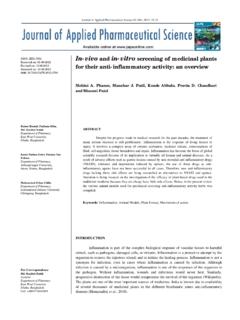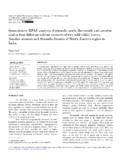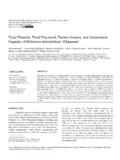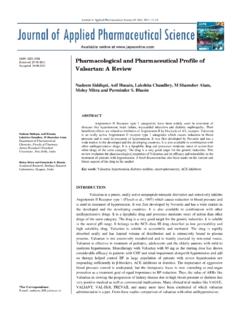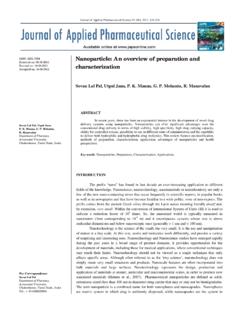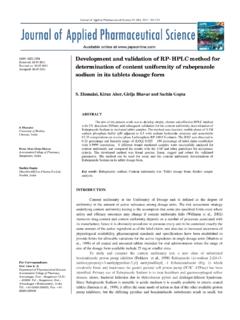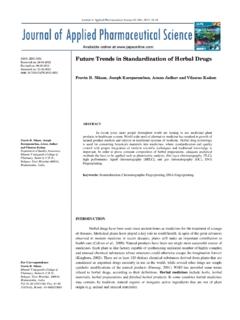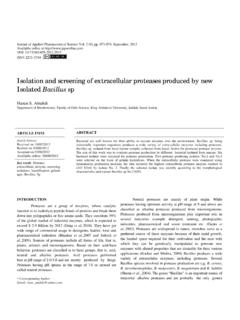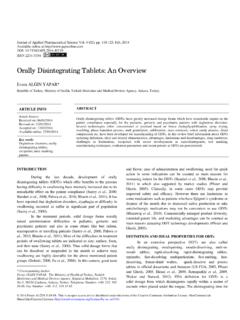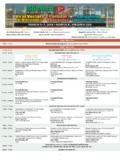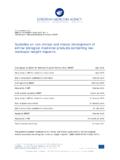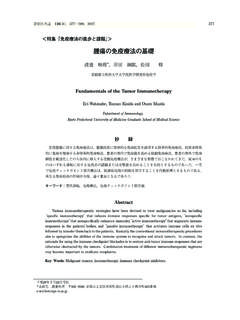Transcription of Drug-Induced Hepatotoxicity: A Review
1 Journal of Applied Pharmaceutical Science 02 (05); 2012: 233-243 ISSN: 2231-3354 Received on: 23-11-2011 Revised on: 09:12:2011 Accepted on: 13-12-2011 DOI: Aashish Pandit, Tarun Sachdeva and Pallavi Bafna Rayat Institute of Pharmacy, Railmajra, Distt. Nagar, Punjab, Pin: 144533, India. For Correspondence Dr. Pallavi Bafna Professor of Pharmacology, Rayat Institute of Pharmacy, Railmajra, Dist. Nawanshahar, Punjab -144533 (INDIA).
2 Tel: +91-8146446996 Drug-Induced hepatotoxicity : A Review Aashish Pandit, Tarun Sachdeva and Pallavi Bafna ABSTRACT Liver is the principle organ for maintaining the body s internal environment. There is currently no way to reimburse for the absence of liver function. Its major influence is on the flow of nutrients and controls the metabolism of carbohydrate, protein and fats. Drugs are an important cause of liver injury. More than 900 drugs, toxins, and herbs have been reported to cause liver injury. Approximately 75% of the idiosyncratic drug reactions result in liver transplantation or death.
3 Various types of drug induced liver diseases are acute-dose dependent liver damage, acute fatty infiltration, cholestatic jaundice, liver granulomas, active chronic hepatitis, liver cirrhosis, liver tumors etc. In the United States, approximately 2000 cases of acute liver failure occur annually and drugs account for over 50% of them (37% are due to acetaminophen, 13% are idiosyncratic reactions due to other medications). Drugs account for 2-5% of cases of patients hospitalized with jaundice and approximately 10% of all cases of acute hepatitis.
4 Chronic liver disease and cirrhosis account for some 2% of mean in 17 countries with nearly 40,000 deaths per year. Considering the importance of Drug-Induced hepatotoxicity as a major cause of liver damage, this Review throws light on various drugs which induce hepatotoxicity , with their mechanism of liver damage and clinical scenario. Keywords: Liver, hepatotoxicity , drug , mechanism. INTRODUCTION The liver plays an astonishing array of vital functions in the maintenance, performance and regulating homeostasis of the body. It is involved with almost all the biochemical pathways to growth, fight against disease, nutrient supply, energy provision and reproduction (Sharma et al.)
5 , 1991). The major functions of the liver are carbohydrate, protein and fat metabolism, detoxification, secretion of bile and storage of vitamin. Thus, to maintain a healthy liver is a crucial factor for the overall health and well being (Subramaniam and Pushpangadan, 1999). hepatotoxicity implies chemical-driven liver damage. Certain medicinal agents, when taken in overdoses and sometimes even when introduced within therapeutic ranges, may injure the organ. Other chemical agents, such as those used in laboratories and industries, natural chemicals ( , microcystins) and herbal remedies can also induce hepatotoxicity .
6 Chemicals that cause liver injury are called hepatotoxins. More than 900 drugs have been implicated in causing liver injury and it is the most common reason for a drug to be withdrawn from the market. Chemicals often cause subclinical injury to liver which manifests only as abnormal liver enzyme tests. Drug-Induced liver injury is responsible for 5% of all hospital admissions and 50% of all acute liver failures. More than 75 percent of cases of idiosyncratic drug reactions result in liver transplantation or death (Ostapowicz et al.)
7 , 2002). Journal of Applied Pharmaceutical Science 02 (05); 2012: 233-243 HEPATOTOXIC DRUGS Anti-Tubercular Drugs The first line anti-tubercular drugs namely, Rifampicin, Isoniazid and Pyrazinamide are potentially hepatotoxic drugs. These drugs are metabolized by the liver. No hepatotoxicity has been described for Ethambutol or Streptomycin. Adverse effects of antitubercular therapy are sometimes potentiated by multiple drug regimens. Thus, though INH, Rifampicin and Pyrazinamide each in itself are potentially hepatotoxic, when given in combination, their toxic effect is enhanced.
8 Based on hepatotoxicity diagnosis criteria and population under study, incidence of anti-TB related hepatotoxicity is reported from 2% to 28% (Girling, 1978). Rifampicin Patients on concurrent Rifampicin therapy have an increased incidence of hepatitis. This has been postulated due to Rifampicin- induced cytochrome P450 enzyme-induction, causing an increased production of the toxic metabolites from acetyl hydrazine (AcHz). Rifampicin also increases the metabolism of INH to isonicotinic acid and hydrazine, both of which are hepatotoxic.
9 The plasma half life of AcHz (metabolite of INH) is shortened by Rifampicin and AcHz is quickly converted to its active metabolites by increasing the oxidative elimination rate of AcHz, which is related to the higher incidence of liver necrosis caused by INH and Rifampicin in combination. Rifampicin also interacts with antiretroviral drugs and affects the plasma levels of these drugs as well as risk of hepatotoxicity (Padma et al., 1998; Tostmann et al., 2008). Isoniazid Isoniazid hepatotoxicity is a common complication of antituberculosis therapy that ranges in severity from asymptomatic elevation of serum transaminases to hepatic failure requiring liver transplantation.
10 This is not caused by high plasma Isoniazid levels but appears to represent an idiosyncratic response. INH is metabolized to monoacetyl hydrazine, which is further metabolized to a toxic product by cytochrome P450 leading to hepatotoxicity . Human genetic studies have shown that cytochrome P4502E1 (CYP2E1) is involved in anti tubercular drug hepatotoxicity (Huang et al., 2003). The CYP2E1 c1/c1 genotype is associated with a higher CYP2E1 activity and may lead to a higher production of hepatotoxins. Rat studies showed that Isoniazid and Hydrazine induce CYP2E1 activity (Jenner and Timbrell, 1994; Jenner and Timbrell, 1995).
